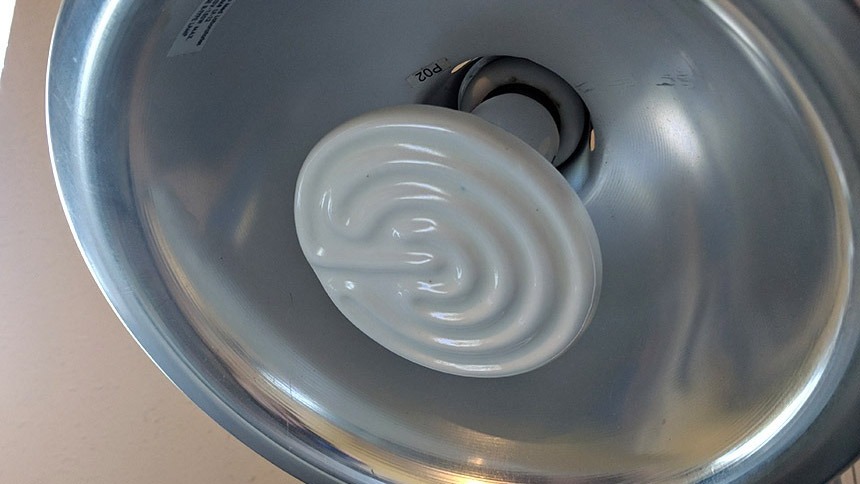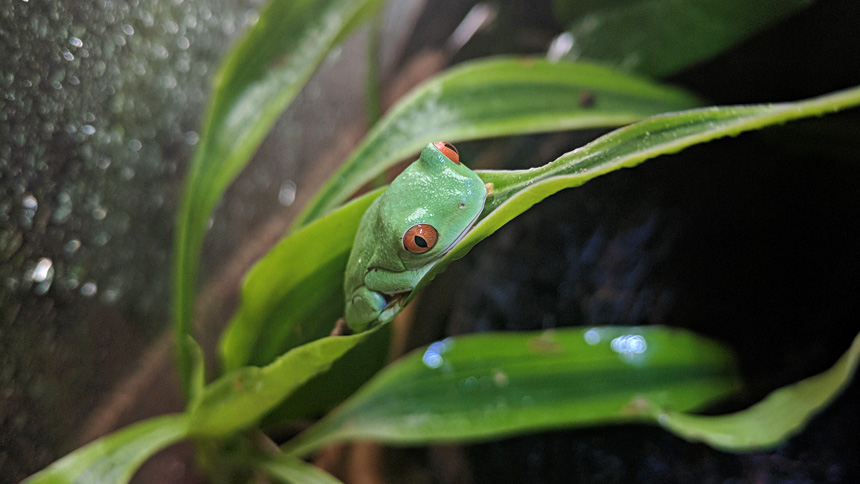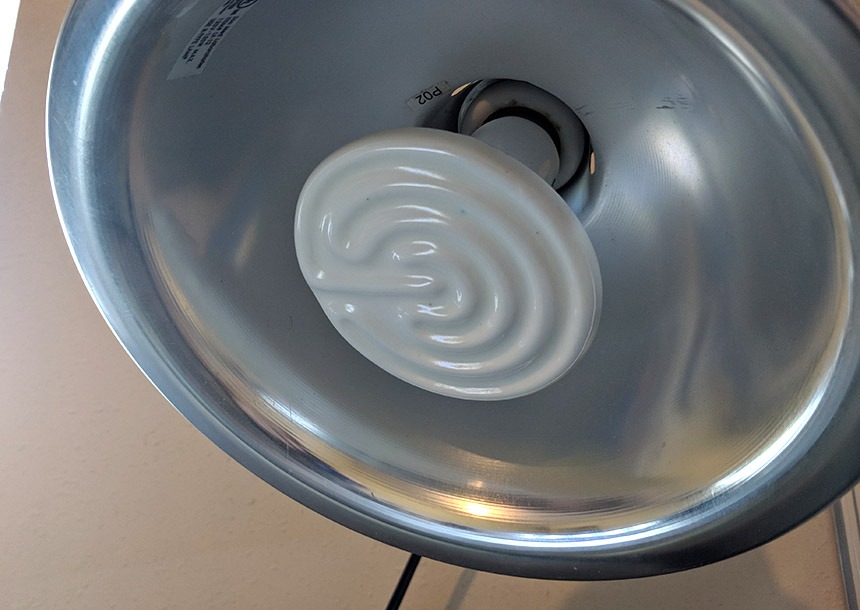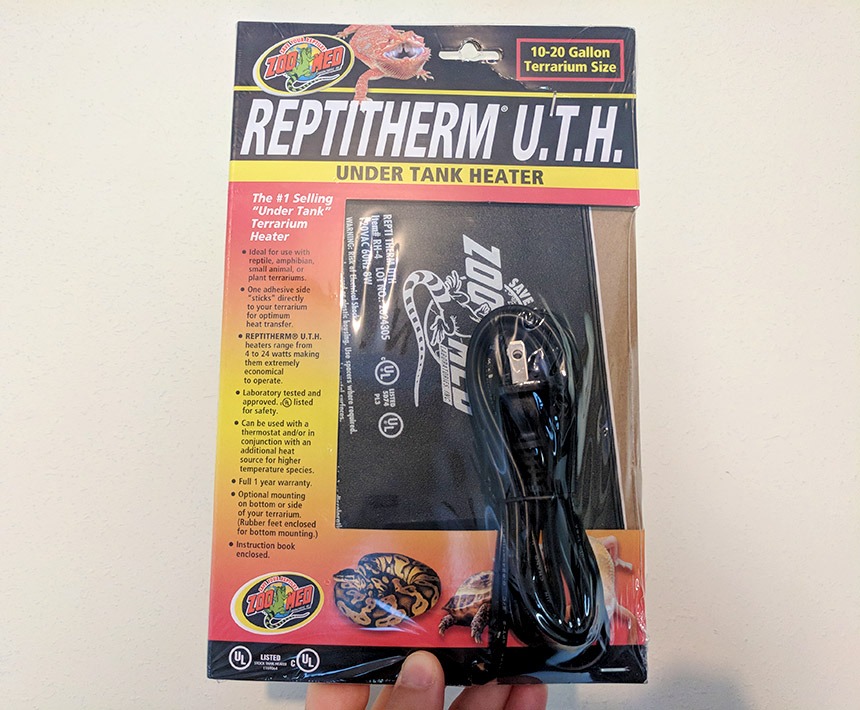
Do Tree Frogs Need A Heat Lamp?
The temperature of your tree frog’s enclosure is one of the most important parts of caring for them. Some species require a tropical climate while others hibernate during the winter months.
Because of that, it can be hard to tell whether or not they need a heat lamp. It’s a great question; one I’ll do my best to answer by the end of this page.
In short, you need a heating device if your tree frog requires warmer temperatures than you’re able to provide with the normal room temperature. You can use a heat lamp or heat mat. Heat lamps / ceramic heat emitters do a better job heating than heating pads but they dry out the habitat faster.
Page Contents
Do You Need a Heating Device?
The first thing you need to know is whether or not you need a heating device. This can be determined by learning the requirements of your tree frog.
Red-Eyed Tree Frogs, for example, are from a part of the world where temperatures rarely go below 65 °F or above 85 °F. During the day, the temperature should be in the low 80s while at night time, it can fall to the low 70s or high 60s.
In my house, the temperature is usually between 68 – 73 degrees Fahrenheit. Those temperatures are okay at night, but during the day, a RETF would prefer it to be warmer.
In this example, a heating device would be needed to raise the temperature of the enclosure during the day.

There are a lot of species of tree frogs and they all have different requirements. So, first things first, learn the requirements of your frog. The next step is to check the temperature in the terrarium. F
or this, I recommend getting a digital thermometer/hygrometer. Check the temperature and determine whether or not you need a heating element based on your tree frog’s requirements.
If you don’t know the requirements of your frog, it’s a good idea to find a care sheet from a reputable source. I have a small collection of care sheets on this website but if I don’t have one for your type of tree frog, try searching google for more information.
Heat Lamp or Heat Pad?
Once you’ve determined whether or not you need a heating device, the next step is to get one. Pretty simple, right? Well, kind of. Keep reading so I can help you decide which one is right for you.
Heat Lamps

Heat lamps are often made from ceramic. In the reptile and amphibian industry, you have several options to choose from. All you really need is a nice, dependable heat lamp to warm your terrarium.
A word of caution, though. Sitting a large heat lamp directly on the top of a terrarium can cause problems. One, if the actual lamp is touching the screen lid, it can hurt your tree frog if it happens to
Two, sitting the heat lamp on a screen lid can cause the screen to sag over an extended period of time.
For this reason, it’s a good idea to get a heat lamp with a clamp and arm. I’ve been using this Zoo Med Clamp Lamp for my RETF (Red Eyed Tree Frog) terrarium for a while now and it does a great job.
My only complaint is that I cannot clamp it directly to the terrarium; I have it clamped on a nearby shelf. I positioned the lamp several inches above the enclosure because it made the tank too hot otherwise.
You will have to adjust the distance between the lamp and the enclosure in order to get the correct temperature. Consider purchasing a reptile lamp stand for a more secured approach with a better appeal.
The best method for controlling the temperature inside your frog’s habitat is by the use of a thermostat. A reptile thermostat helps regulate the temperature by turning the heating device on/off depending not the temperature.
Heating Pads
So, the alternative to a heat lamp is what’s known as an “Under Tank Heater”. They’re designed to slide under your tank and heat from the bottom up. You don’t always have to place them under your terrarium though; you can stick them on the side if you want.

Make sure you get the correct size! I accidentally got one that was too small for my terrarium. It barely raised the temperature at all.
Granted, it’s too small for the enclosure and it’s my fault for getting the wrong size. I still like it. I’m happy with it. It doesn’t get too hot and it’s still running as good as the day I got it.
There are a few brands selling heating pads but the only one I’ve tested is the Zoo Med ReptiTherm UTH (click here to check the price). Again, whether you buy one online or in a pet store, make sure you get the correct size.
Zoo Med offers different sizes and I believe they’re labeled in the top right corner of one side (1-5 gallon, 5-10 gallon, 10-20 gallon, etc).
For more reading on heating pads, check out our post on the best heating pads for reptiles & amphibians.
Conclusion
Whether or not a tree frog needs a heat lamp depends on the requirements of the species and what the temperature is like in their tank. A heat lamp is not always required but you should do your best to keep your frog comfortable. That means providing a suitable climate for them to live in.
Be mindful of where you put your tree frog’s enclosure too. While the main living area of your house could be 72 °F during the day in the middle of summer, the temperature of an upstairs room near a window could be drastically different.
Knowing the temperature on the inside of the tank is the best way to determine if you need a heating source.
Not only is the temperature important but so is the humidity. I know I mentioned this already but the best way to check the temperature and humidity is by installing a thermometer/hygrometer.
Some of them track the highs and lows over 24 hours, which is a great way to see the lowest temperature at night and the highest temperature during the day.
Anyway, I hope this page helped you. If so, please consider sharing with friends! Also, have a look around the website and feel free to leave a reply in the comment section below.

Leave a Reply